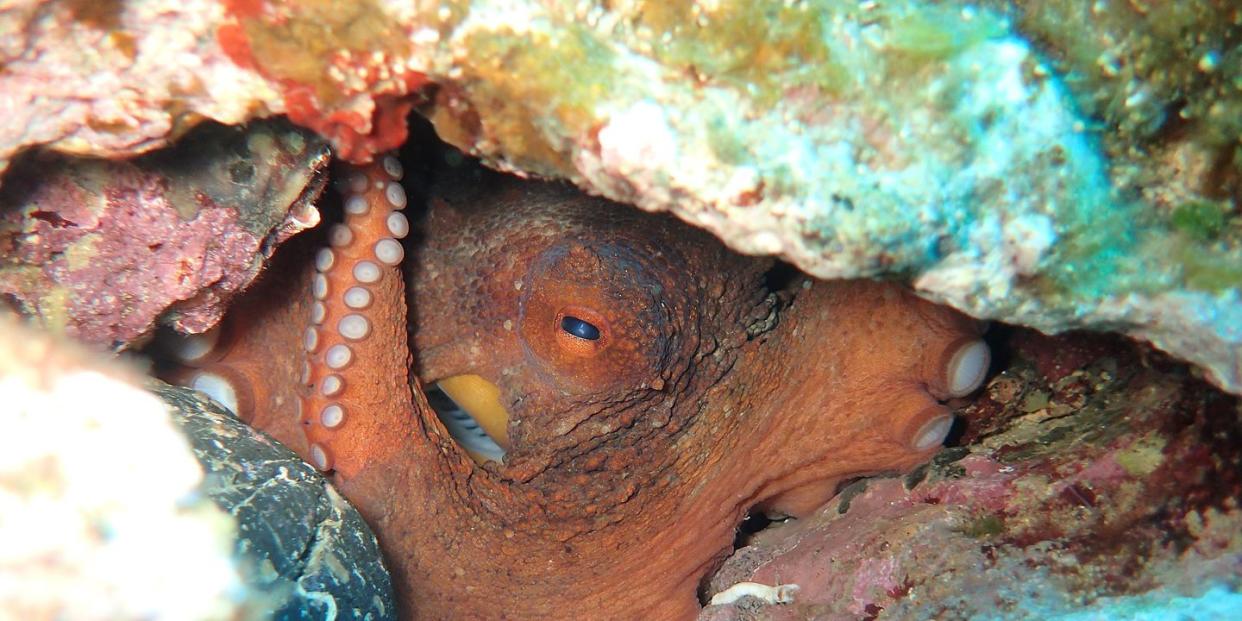Octopuses Take Ecstasy for Science and Become More Social Creatures

Give an octopus a little MDMA and the usually solitary creature will open right up. That's according to research published today in Current Biology.
In the study, Johns Hopkins Medical researchers gave MDMA-a drug more commonly known as ecstasy-to a group of California two-spot octopuses. The genome of that octopus is well understood, making it an ideal study.
As it turns out, octopuses-and virtually every animal on Earth, save ants and honeybees-have a specific serotonin transporter. In humans, this transporter regulates mood and, when exposed to MDMA, loosens social inhibitions-part of why ecstasy is so popular as a party drug. It's believed to also serve a role in social functioning.
Gül Dölen, one of the co-investigators on the paper, wanted to test if it would enable this same response in this particular octopus, noted for its solitary lifestyle. It's one of the first MDMA tests to use a non-mammalian subject-let alone invertebrate.
"People who study mammalian brains, and especially people who study human brains, find it easy to dismiss fruit flies and worms," Dölen says, dismissing them because these simpler creatures don't have the "rich complexity" of more advanced species. The cephalopods are the family that includes octopuses, on the other hand, which are reknowned for their intelligence. "It’s really hard to dismiss that with an octopus because they’re pretty smart and are capable of all sorts of sophisticated things, and they have a brain very different from mammals," Dölen says. Despite the vast differences between humans and octopuses, though, the transporter appeared to work virtually the same.
MDMA was administered to five male octopuses and one female octopus, who were then placed in the same tank. The octopuses were also given an object to distract themselves with. Normally, they might opt for this "toy" and eschew all contact with members of their species save for mating season. While there was a noted tendency toward socializing with the one female octopus, the male octopuses socialized under certain conditions, something virtually unheard of outside of aggressive scenarios in the wild.
"What we found is that when the animals, when they were just in saline, they preferred to spend time with the object instead of the other octopus, but after MDMA, they preferred the other octopus over the object," Dölen says.
MDMA, usually seen as a party drug, has emerged in recent years as a potential treatment for PTSD and clinical depression, thanks to the way it regulates mood and social behavior. "It’s very exciting therapy, but we really don’t know how it’s working and what it’s doing," Dölen says. "We know the first steps, but we don’t know a lot in between binding to the serotonin transporter and treating your PTSD." But seeing how it works in mice, octopuses, and other animals helps researchers gain a sense of how it fits into the evolution of all animals on Earth. Even solitary ones.
"I think that what this suggests to me, in any case, is that social behavior is there for these octopuses," Dölen says. "They have it, but it’s so important for their ability to adapt to their environment that they turn it off."
She next wants to move the research towards two other species of octopus, the large pacific striped octopus and the pygmy zebra octopus. The former is known for being an octopus that, unlike some of its brethren, is very social, going so far as to live in colonies and keep the same mate for long periods of time. This behavior is more akin to cuttlefish, another cephalopod noted for its social behavior.
Giving the drug to more social creatures could help further understand the serotonin transporter and its role in almost every animal on Earth. After all, vertebrates only came on the scene 500 million years ago-meaning nature saw fit to keep this adaptation for a long time before that.
"Dinosaurs came and went in the interval that we’re talking about," Dölen says. "It’s been a part of our genetic makeup for such a long time that maybe it explains why social behaviors are so important in humans."
('You Might Also Like',)

